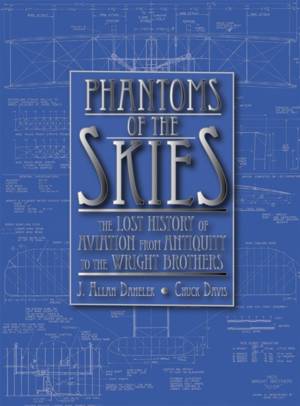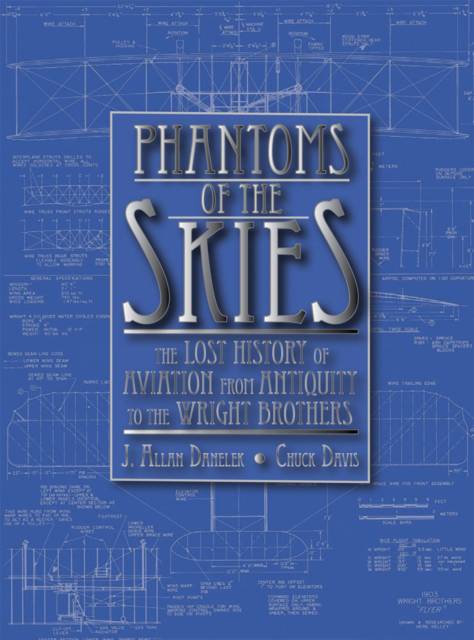
En raison d'une grêve chez bpost, votre commande pourrait être retardée. Vous avez besoin d’un livre rapidement ? Nos magasins vous accueillent à bras ouverts !
- Retrait gratuit dans votre magasin Club
- 7.000.000 titres dans notre catalogue
- Payer en toute sécurité
- Toujours un magasin près de chez vous
En raison de la grêve chez bpost, votre commande pourrait être retardée. Vous avez besoin d’un livre rapidement ? Nos magasins vous accueillent à bras ouverts !
- Retrait gratuit dans votre magasin Club
- 7.000.0000 titres dans notre catalogue
- Payer en toute sécurité
- Toujours un magasin près de chez vous
Phantoms of the Skies
The Lost History of Aviation from Antiquity to the Wright Brothers
J Allan Danelek, Chuck Davis
Livre broché | Anglais
37,95 €
+ 75 points
Description
It has been traditional to teach school children that Christopher Columbus discovered America, that Charles Lindbergh was the first man to fly across the Atlantic, and that the Wright Brother's invented the airplane. Time has since taught us that the first Europeans to touch foot on the continent of North America were the Vikings and that Lindbergh was the 85th man to cross the Atlantic by air. Would it be any more remarkable to learn, then, that the Wright Brother's brief flight in December of 1903 may not have been the first successful flight of a manned, heavier-than-air powered machine?
This book tells the true story of aviation as it evolved from mankind's first primitive attempts to fly to the remarkable successes of the early twentieth century in a non-technical and even fun way, designed to impress upon the reader that the history of aviation is richer and more remarkable than they ever imagined. It is also a tribute to the men-and a few women-who laid the foundations that made not only Kitty Hawk possible, but Von Zeppelin's great dirigibles a reality as well. Most of the names and events mentioned in this book are known to only a handful of aviation enthusiasts and practically unknown to the general public, making this work an important recounting of the lost history of aviation that demands to be told. Some of it is controversial. Parts of it are contentious, and some of it is even speculative, but all of it is a valuable insight into an era when men dared to dream great dreams and bet their lives on the results. Many times they paid dearly for such presumptuousness, but without their sacrifices, the safety and ease of air travel we enjoy today would not be possible.
But even more than a retelling of history, it is also a compendium of over 150 patent office blueprints produced between 1847 and 1903 that faithfully capture the spirit of the age. Carefully reproduced from original drawings, they perfectly illustrate the enthusiasm of technology that ran through the world during the height of the industrial revolution, and though many of the designs were impractical, fanciful, and even outrageous, they are an important part of the infant steps aviation took as it tried to find its wings at a time when anything was thought to be possible.
This book tells the true story of aviation as it evolved from mankind's first primitive attempts to fly to the remarkable successes of the early twentieth century in a non-technical and even fun way, designed to impress upon the reader that the history of aviation is richer and more remarkable than they ever imagined. It is also a tribute to the men-and a few women-who laid the foundations that made not only Kitty Hawk possible, but Von Zeppelin's great dirigibles a reality as well. Most of the names and events mentioned in this book are known to only a handful of aviation enthusiasts and practically unknown to the general public, making this work an important recounting of the lost history of aviation that demands to be told. Some of it is controversial. Parts of it are contentious, and some of it is even speculative, but all of it is a valuable insight into an era when men dared to dream great dreams and bet their lives on the results. Many times they paid dearly for such presumptuousness, but without their sacrifices, the safety and ease of air travel we enjoy today would not be possible.
But even more than a retelling of history, it is also a compendium of over 150 patent office blueprints produced between 1847 and 1903 that faithfully capture the spirit of the age. Carefully reproduced from original drawings, they perfectly illustrate the enthusiasm of technology that ran through the world during the height of the industrial revolution, and though many of the designs were impractical, fanciful, and even outrageous, they are an important part of the infant steps aviation took as it tried to find its wings at a time when anything was thought to be possible.
Spécifications
Parties prenantes
- Auteur(s) :
- Editeur:
Contenu
- Nombre de pages :
- 328
- Langue:
- Anglais
Caractéristiques
- EAN:
- 9781935487388
- Date de parution :
- 01-07-11
- Format:
- Livre broché
- Format numérique:
- Trade paperback (VS)
- Dimensions :
- 216 mm x 277 mm
- Poids :
- 929 g

Les avis
Nous publions uniquement les avis qui respectent les conditions requises. Consultez nos conditions pour les avis.






